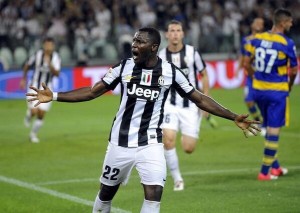Sports Illustrated's Jonathan Wilson profiles the undervalued, under-the-radar but versatile Juventus midfielder Kwadwo Asamoah who is on the cusp of winning his third Scudetto title. In the career of Kwadwo Asamoah is written a parable of the tactical history of African football. When he emerged, making his international debut in 2006 when he was just 17, he was hailed as the first great Ghanaian playmaker since Abedi Pele.
Until a decade or so ago, West Africa specialized in technically gifted attacking midfielders or second strikers - as well as Pele, there were the likes of Nii Lamptey, Theophile Abega, Jay-Jay Okocha and Kanu, players who dropped deep from the front line and had the patience and skill to hold the ball up, wait for a runner and deliver the pass.
Then there came a dearth, something Tom Vernon, who runs a coaching school in the hills above Accra and scouts for Manchester United, blames on "the Papa Bouba Diop" template. His theory is that western European clubs start to associate a region with developing a particular type of player: When they want a Papa Bouba Diop style robust holding midfielder, they look to West Africa. As a result a disproportionate number of holding midfielders are sold from West Africa to Europe, which in turn encourages coaches and academies in West Africa to try to convert any gifted player into a Papa Bouba Diop-style midfielder. Something similar happens in Argentina with No. 10s.
"I see that African football is heading away from flair and more towards the team," said Okocha four years ago.
"Football has changed over the years and there aren't really any playmakers anymore. It's more about tactical work. I see African countries playing more like European ones. That's the only way to become competitive. It's a pity it's at the expense of flair, because fans want to enjoy their money and see good football. If you could combine the flair with goals it would be great. Asamoah stood apart from the template; he seemed to be the answer to Okocha's vision of flair plus productivity. He had quick feet and a good brain and rapidly progressed. He was spotted in Accra playing for his local side Kaaseman at 17 and joined the Ghanaian top flight side Liberty Professionals. In 2008, aged 19, he left Ghana for Europe, joining the Swiss side Bellinzona, before securing a transfer to Udinese. He soon became a regular there and after helping Ghana to the U-20 World Cup in 2009, he established himself as a starter in the senior side, operating as the link between what was often a deep-lying midfield and the lone center forward Asamoah Gyan.
He helped them to the final of the 2010 African Cup of Nations - when Abedi Pele spoke with delight of at last seeing another Ghanaian who did something approaching what he used to do - and the quarterfinal of the World Cup later that year before, in summer 2012, securing a move to Juventus.

HOW HE FITS IN For Ghana, Asamoah still plays in midfield, but he is no longer playing behind a central striker. At the last Cup of Nations, in South Africa last year, he tended to play on the left of a 4-2-3-1, looking to cut infield to support Gyan. More recently, with the emergence of Abdul Waris and the return to the side of Dede Ayew after a dispute with the coach James Appiah, the shape has changed to a 4-3-3, with Asamoah operating to the left of a central trio, alongside two of Michael Essien, Emmanuel Agyemang Badu and Sulley Muntari.
That seems a more natural fit for him and his role is not that different to four years ago: back then the midfield often sat so far back that Asamoah would end playing much deeper than a traditional 10 in the 4-3-3, rather than constantly having to charge back from an advanced position, he is charging forward from deep. WHY HE POSES SUCH A DANGER
At the last two Cups of Nations, Ghana has been weirdly diffirent, lacking the aggression and focus to progress beyond the semifinals. If it has a full squad, though, with Ayew, Essien and Muntari, Ghana ought at least to make a serious challenge to make it through a tough group. If it is to do so, though, it needs Asamoah to be at his best.
He is the central creative intelligence in the side and, as the stars age and Ayew continues to meander, the senior player. Tactically he is the link between midfield and the forward line, but Asmaoah also has a leadership role. It's not the case that if you stop Asamoah you stop Ghana, but the Black Stars will find it much harder if he is not at his best.
By: Jonathan Wilson, Sports Illustrated

